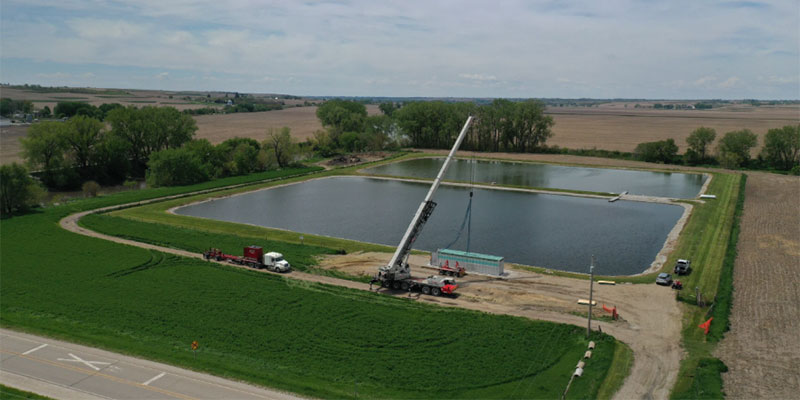
Add aeration or nutrient removal treatment to increase the efficiency of a wastewater treatment lagoon.
Instead of replacing underperforming lagoons, adding treatment solutions can bring facilities into compliance
Lagoon-based wastewater treatment systems have long been a cost-effective and reliable solution, particularly in rural settings. However, as regulatory requirements tighten and treatment demands increase, many lagoon systems struggle to maintain efficiency and compliance with environmental regulations. Rather than replacing an entire system, strategic upgrades of lagoon systems can enhance performance while keeping costs manageable. What are some signs a lagoon system needs an upgrade?
- Sludge accumulation: Over time, lagoons accumulate sludge, which can cause operational inefficiencies and compliance issues. Excessive buildup can overwhelm lagoon capacity, leading to hydraulic short-circuiting and poor effluent quality. Regular desludging or advanced aeration solutions can help restore capacity and improve treatment effectiveness, but if such measures are neglected for too long, operators often conclude remediation may no longer be viable and that complete replacement is necessary. However, new upgrade options can rehabilitate lagoon systems.
- Frequent odor issues: Persistent odors indicate inadequate aeration, which can lead to anaerobic conditions. If your lagoon emits strong, unpleasant smells, it may be time to consider aeration upgrades. Proper oxygenation can mitigate odor issues while improving biological treatment efficiency.
- Algal blooms: Excessive algal growth can disrupt treatment efficiency, leading to inconsistent effluent quality. Algal blooms often result from nutrient imbalances and insufficient circulation. Upgrading aeration or implementing nutrient removal enhancements can help stabilize lagoon performance.
- Seasonal performance variability: Temperature fluctuations can significantly impact lagoon treatment efficiency. Cold weather can slow biological processes, while warmer temperatures may accelerate unwanted microbial activity.
Updated nitrogen and phosphorus limits are pushing lagoon systems to adopt advanced wastewater treatment technologies. These seasonal impacts may require adaptive treatment strategies to maintain compliance year-round. What are some of the methods available to address these concerns with lagoon systems? They include:
- Aeration upgrades: Boosting dissolved oxygen levels is critical for maintaining effective biological treatment. High-efficiency aerators or partial mix aeration systems can enhance oxygen transfer, improving microbial activity and overall treatment performance.
- Sludge management: Regular sludge removal helps restore lagoon capacity and improve effluent quality. Implementing sludge management strategies can prevent excessive accumulation and maintain system efficiency.
- Tertiary treatment for nutrient removal: Advanced filtration, dissolved air flotation (DAF) systems, or chemical dosing can improve nutrient removal, ensuring compliance with stricter discharge regulations. These upgrades help lagoons meet evolving environmental standards while maintaining operational efficiency.
If upgrades like aeration or tertiary treatment cannot bring a lagoon into compliance, adding an enhanced nutrient removal solution can ensure regulatory adherence while improving effluent quality.
Upgrading With MABR Technology
Modular, containerized membrane aerated biofilm reactor (MABR) solutions like Fluence’s Aspiral™ Flex units can revolutionize lagoon-based treatment, supplementing the natural action of the lagoon process. What are the benefits of MABR?
MABR helps maintain year-round performance by optimizing biological treatment for high nutrient removal. It enables simultaneous nitrification and denitrification (SND) in a single tank, eliminating the need for separate aerobic and anoxic zones for a smaller physical footprint. The biofilm formed in MABR creates a microbial ecosystem that adapts to load variations and resists environmental stressors in the field — UV radiation, extreme temperatures, salt, and antibiotics. This resilience minimizes operational disruptions and reduces maintenance demands.
Because MABR streamlines treatment by delivering oxygen directly through a semipermeable membrane at near-atmospheric pressure, energy consumption is very low, to the point that the systems can be operated on alternative energy sources like solar arrays.
Time for an Upgrade?
Aspiral™ Flex units can upgrade lagoon systems cost effectively, making a difficult total replacement unnecessary. Lagoon systems struggling with compliance, efficiency, or capacity can serve again with a quick, modular, energy-efficient solution. To learn more about Fluence lagoon solutions, contact our experts to explore the best strategy for your wastewater lagoon.
